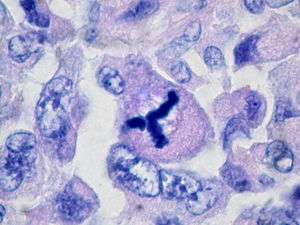Sarcomatoid carcinoma
Sarcomatoid carcinoma, sometimes referred to as pleomorphic carcinoma,[1] is a relatively uncommon form of cancer whose malignant cells have histological, cytological, or molecular properties of both epithelial tumors ("carcinoma") and mesenchymal tumors ("sarcoma"). It is believed that sarcomatoid carcinomas develop from more common forms of epithelial tumors.[2]
| Sarcomatoid carcinoma | |
|---|---|
 | |
| Metaplastic (sarcomatoid) carcinoma of the breast. | |
| Specialty | Oncology |
Sarcomatoid carcinoma locations
Histological variants of lung cancer classified as sarcomatoid carcinoma include giant cell carcinoma, spindle cell carcinoma, carcinosarcoma, and pulmonary blastoma.
Sarcomatoid carcinomas have been identified in the small intestine in rare cases. They may have epithelioid and mesenchymal properties or be composed only of mesenchymal-type spindle cells, and are negative for CD117 and DOG1.[3]
Some cases of sacromatoid carcinoma of the larynx are resistant to radiotherapy.[2]
References
- Tumors and Tumor-like Conditions of the Lung and Pleura. Elsevier. 2010. pp. 51–110.
- Clinical Radiation Oncology. Elsevier. 2016. pp. 649–472.
- Odze and Goldblum Surgical Pathology of the GI Tract, Liver, Biliary Tract and Pancreas. Saunders. 2015. pp. 722–736.